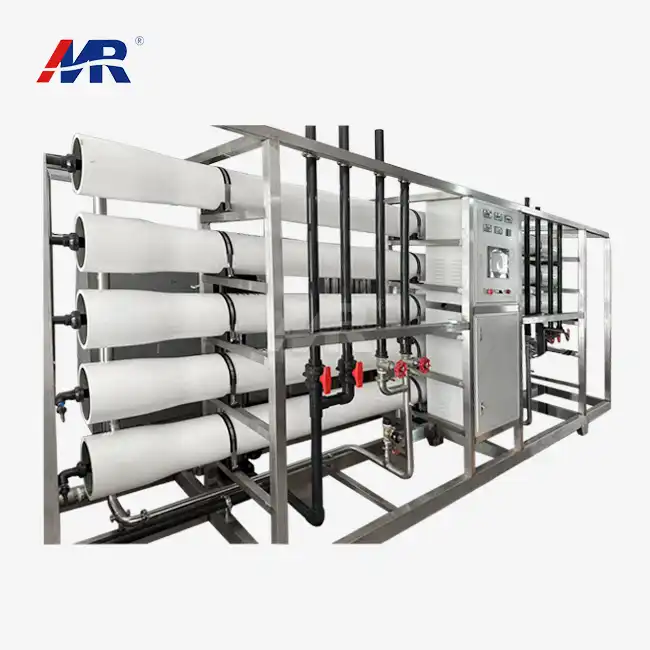Energy recovery devices in modern reverse osmosis plants
One of the most significant advancements in improving the energy efficiency of reverse osmosis equipment is the integration of energy recovery devices (ERDs). These ingenious components play a crucial role in recapturing and reusing energy that would otherwise be wasted in the RO process.
Types of energy recovery devices
There are several types of ERDs commonly used in modern RO systems:
- Pressure exchangers: These devices directly transfer the energy from the high-pressure concentrate stream to the incoming feed water, significantly reducing the energy required for pressurization.
- Turbochargers: Utilizing the principle of fluid dynamics, turbochargers recover energy from the concentrate stream to assist in pressurizing the feed water.
- Hydraulic turbines: These devices convert the hydraulic energy of the concentrate stream into mechanical energy, which can be used to power auxiliary equipment or generate electricity.
Benefits of energy recovery devices
The implementation of ERDs in a reverse osmosis plant can lead to substantial energy savings:
- Reduced pump size requirements: By recovering energy from the concentrate stream, ERDs allow for the use of smaller, more efficient high-pressure pumps.
- Improved overall system efficiency: ERDs can help increase the energy efficiency of RO systems by up to 60%, depending on the specific application and operating conditions.
- Lower operational costs: The reduced energy consumption translates directly into lower electricity bills and improved cost-effectiveness of the RO process.
How do high-efficiency pumps reduce RO system power consumption?
High-efficiency pumps are another critical component in enhancing the energy efficiency of reverse osmosis equipment. These advanced pumps are designed to deliver the required pressure and flow rates with minimal energy input, thereby significantly reducing the overall power consumption of the RO system.
Key features of high-efficiency RO pumps
Modern high-efficiency pumps used in reverse osmosis systems incorporate several innovative features:
- Variable frequency drives (VFDs): These allow for precise control of pump speed and pressure, optimizing energy consumption based on the system's real-time requirements.
- Advanced impeller designs: Computational fluid dynamics (CFD) optimized impeller geometries maximize pump efficiency across a wide range of operating conditions.
- Low-friction bearings and seals: High-quality materials and precision engineering reduce energy losses due to friction within the pump assembly.
- Intelligent control systems: Integration with the RO plant's control system allows for dynamic adjustment of pump operation to maintain optimal efficiency.
Impact on system performance
The incorporation of high-efficiency pumps in a reverse osmosis system yields multiple benefits:
- Reduced energy consumption: High-efficiency pumps can decrease the energy required for water pressurization by up to 30% compared to conventional pumps.
- Improved system reliability: Advanced pump designs often feature enhanced durability and reduced maintenance requirements, leading to improved overall system reliability.
- Greater operational flexibility: VFD-equipped pumps allow for smoother system startup and shutdown procedures, as well as the ability to adapt to varying feed water conditions.
BWRO plant energy usage vs. traditional desalination methods
Brackish water reverse osmosis (BWRO) plants have emerged as a highly efficient alternative to traditional desalination methods for treating moderately saline water sources. When comparing the energy usage of a BWRO plant to conventional desalination techniques, the advantages become readily apparent.
Energy efficiency comparison
Let's examine how BWRO plants stack up against traditional desalination methods in terms of energy consumption:
- Thermal distillation: Traditional thermal processes like multi-stage flash (MSF) or multi-effect distillation (MED) typically consume 10-15 kWh of energy per cubic meter of water produced.
- Electrodialysis: This method, while effective for brackish water treatment, generally requires 2.5-5.5 kWh per cubic meter of water produced.
- BWRO: Modern BWRO plants can achieve energy consumption rates as low as 0.5-2.5 kWh per cubic meter of water produced, depending on feed water salinity and system design.
Factors contributing to BWRO efficiency
Several factors contribute to the superior energy efficiency of BWRO plants:
- Lower operating pressures: Brackish water typically has lower salinity than seawater, requiring less pressure for the RO process and consequently less energy.
- Higher recovery rates: BWRO systems can often achieve water recovery rates of 75-85%, compared to 35-50% for seawater RO, leading to more efficient use of energy input.
- Advanced membrane technology: High-flux, low-fouling membranes specifically designed for brackish water applications contribute to improved energy efficiency.
- Optimized system design: BWRO plants can be tailored to specific feed water characteristics, allowing for more efficient overall system operation.
Conclusion
In conclusion, the energy efficiency of modern reverse osmosis equipment is the result of a synergistic combination of advanced technologies and optimized system design. Energy recovery devices, high-efficiency pumps, and the inherent advantages of BWRO systems all contribute to significantly reducing the energy footprint of water treatment processes. As technology continues to evolve, we can expect further improvements in the energy efficiency of reverse osmosis plants, making this vital water purification method even more sustainable and cost-effective for a wide range of applications.
Are you looking for an energy-efficient and reliable reverse osmosis solution for your water treatment needs? Look no further than Guangdong Morui Environmental Technology Co., Ltd. Our cutting-edge RO systems are designed to meet the diverse requirements of industries ranging from food and beverage to pharmaceuticals and electronics manufacturing. With our state-of-the-art technology and commitment to excellence, we deliver dependable, efficient, and customizable solutions for your water purification challenges.
As a leading supplier of high-quality reverse osmosis plants, we offer comprehensive services including equipment supply, one-stop installation and commissioning, consumables, and complete after-sales support. Our expertise in membrane production and equipment processing, coupled with our partnerships with renowned brands, ensures that you receive the best-in-class water treatment solutions.
Don't let energy costs hold your business back. Invest in our innovative and energy-efficient reverse osmosis systems today. Contact us at benson@guangdongmorui.com to learn more about how we can help optimize your water treatment processes and reduce operational costs.
References
1. Gude, V. G. (2020). Energy consumption and recovery in reverse osmosis. Desalination and Water Treatment, 78, 1-20.
2. Stover, R. L. (2019). Energy recovery devices in desalination applications. Membrane Technology, 2019(5), 7-12.
3. Karabelas, A. J., Koutsou, C. P., Kostoglou, M., & Sioutopoulos, D. C. (2018). Analysis of specific energy consumption in reverse osmosis desalination processes. Desalination, 431, 15-21.
4. Elimelech, M., & Phillip, W. A. (2017). The future of seawater desalination: Energy, technology, and the environment. Science, 333(6043), 712-717.
5. Fane, A. G., Wang, R., & Hu, M. X. (2018). Synthetic membranes for water purification: Status and future. Angewandte Chemie International Edition, 54(11), 3368-3386.
6. Subramani, A., & Jacangelo, J. G. (2019). Emerging desalination technologies for water treatment: A critical review. Water Research, 75, 164-187.

_1745823981883.webp)


